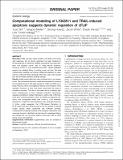| dc.contributor.author | Shi, Y | |
| dc.contributor.author | Mellier, G | |
| dc.contributor.author | Huang, S | |
| dc.contributor.author | White, J | |
| dc.contributor.author | Pervaiz, S | |
| dc.contributor.author | Tucker-Kellogg, L | |
| dc.date.accessioned | 2021-10-27T20:05:59Z | |
| dc.date.available | 2021-10-27T20:05:59Z | |
| dc.date.issued | 2013-02-01 | |
| dc.identifier.uri | https://hdl.handle.net/1721.1/134649 | |
| dc.description.abstract | Motivation: TRAIL has been widely studied for the ability to kill cancer cells selectively, but its clinical usefulness has been hindered by the development of resistance. Multiple compounds have been identified that sensitize cancer cells to TRAIL-induced apoptosis. The drug LY303511 (LY30), combined with TRAIL, caused synergistic (greater than additive) killing of multiple cancer cell lines. We used mathematical modelling and ordinary differential equations to represent how LY30 and TRAIL individually affect HeLa cells, and to predict how the combined treatment achieves synergy.Results: Model-based predictions were compared with in vitro experiments. The combination treatment model was successful at mimicking the synergistic levels of cell death caused by LY30 and TRAIL combined. However, there were significant failures of the model to mimic upstream activation at early time points, particularly the slope of caspase-8 activation. This flaw in the model led us to perform additional measurements of early caspase-8 activation. Surprisingly, caspase-8 exhibited a transient decrease in activity after LY30 treatment, prior to strong activation. cFLIP, an inhibitor of caspase-8 activation, was up-regulated briefly after 30 min of LY30 treatment, followed by a significant down-regulation over prolonged exposure. A further model suggested that LY30-induced fluctuation of cFLIP might result from tilting the ratio of two key species of reactive oxygen species (ROS), superoxide and hydrogen peroxide. Computational modelling extracted novel biological implications from measured dynamics, identified time intervals with unexplained effects, and clarified the non-monotonic effects of the drug LY30 on cFLIP during cancer cell apoptosis.Supplementary information: Supplementary data are available at Bioinformatics online. © 2012 The Author. | |
| dc.language.iso | en | |
| dc.publisher | Oxford University Press (OUP) | |
| dc.relation.isversionof | 10.1093/bioinformatics/bts702 | |
| dc.rights | Creative Commons Attribution 3.0 unported license | |
| dc.rights.uri | https://creativecommons.org/licenses/by/3.0/ | |
| dc.source | Bioinformatics | |
| dc.title | Computational modelling of LY303511 and TRAIL-induced apoptosis suggests dynamic regulation of cFLIP | |
| dc.type | Article | |
| dc.identifier.citation | Shi, Y., et al. "Computational Modeling of Ly303511 and Trail-Induced Apoptosis Suggests Dynamic Regulation of Cflip." Bioinformatics (2012). | |
| dc.contributor.department | Singapore-MIT Alliance in Research and Technology (SMART) | |
| dc.contributor.department | Massachusetts Institute of Technology. Department of Electrical Engineering and Computer Science | |
| dc.relation.journal | Bioinformatics | |
| dc.eprint.version | Final published version | |
| dc.type.uri | http://purl.org/eprint/type/JournalArticle | |
| eprint.status | http://purl.org/eprint/status/PeerReviewed | |
| dc.date.updated | 2019-07-09T14:15:18Z | |
| dspace.orderedauthors | Shi, Y; Mellier, G; Huang, S; White, J; Pervaiz, S; Tucker-Kellogg, L | |
| dspace.date.submission | 2019-07-09T14:15:19Z | |
| mit.journal.volume | 29 | |
| mit.journal.issue | 3 | |
| mit.metadata.status | Authority Work and Publication Information Needed | |
